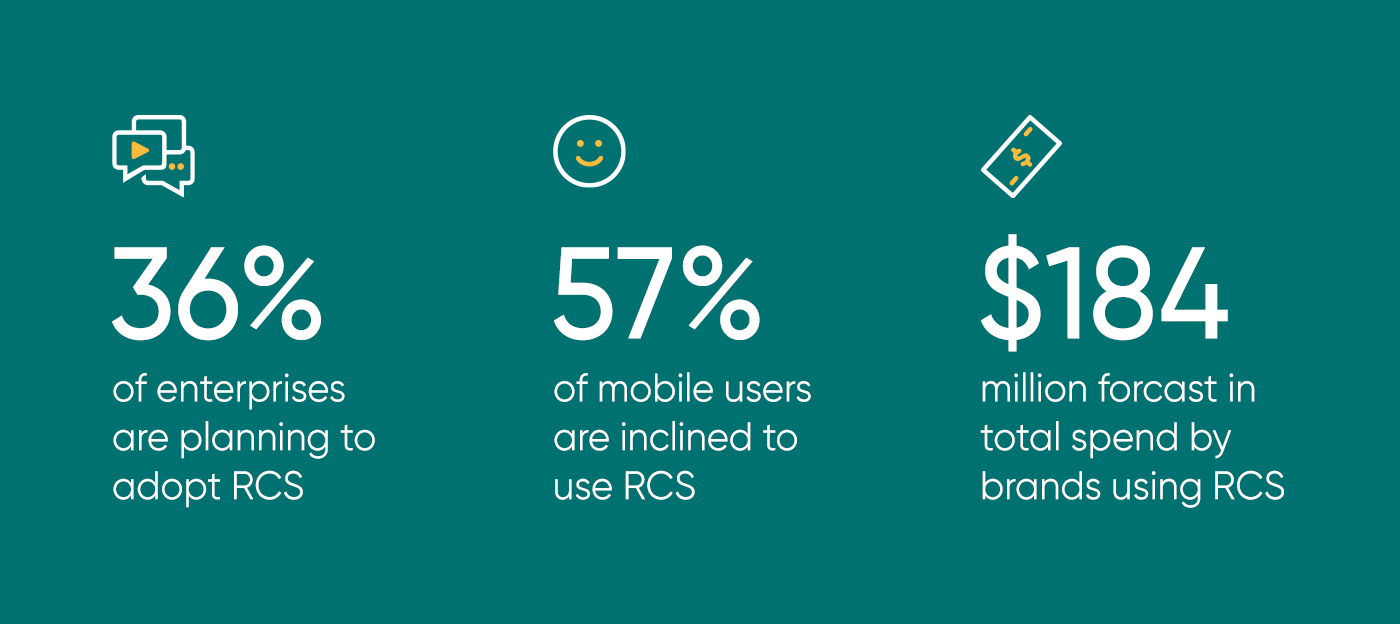In this article:
Back in 1995, the average SMS user in the US sent 0.4 texts per month. Gradually, phone and network technology improved and by 2000, the average number of text messages sent in the US increased to 35 a month per person.
Arguably SMS really took off when enterprises began to realize they had a new and powerful communication channel that put them ‘in the pocket’ of any mobile phone user. And while much has changed since those early days, SMS has held up against other technology platforms as the preferred (non-voice) way to communicate for businesses and consumers.
Here’s 11 stats and facts that explore the mighty SMS.
A2P SMS is still winning
-
Analyst firm Mobilesquared forecasts that two trillion text messages will be sent to consumers by 2022.
-
That’s hardly surprising. In this study from mobile trade body MEF, most respondents chose SMS (35%) over messaging apps (28%), Facebook (18%) and push notification (16%) as the most trusted way to communicate with a company.
-
SMS is everywhere. Unlike chat apps, it works on every network. Every phone, from dumb to smart, has SMS as a baked in feature. That’s important because not everyone owns a smart device, and not everyone has access to a 4G network. Deloitte pegs smartphone ownership at 80% and any phone ownership at 91%, a disparity that grows in developing countries. In other words, SMS can reach at least 10% more of your customers.
-
Who can resist opening an SMS? (It turns out just 2% of us). This Black Friday study indicates that SMS still boasts a 98% read rate and a 10 times higher click through rate than email.

Customer service 24/7
SMS is used for an array of business to consumer needs. Everything is fair game from notifying us that a parcel is on its way (and the delivery driver is called Roger) to authenticating us as users of sensitive online services like banking.
At the same time, consumer expectation on ways to communicate with enterprises has shifted gears. They no longer want to be talked to, they want a conversation when the need takes them – on the train, waiting for friends in a café or while watching TV. Nowhere is this more apparent than in the realm of customer service. But brands and enterprises are struggling to fulfil this need.
-
This consumer study by West UC, found that 70% of respondents want more convenient customer service options to support 24/7 lifestyles, while 74% agree that it’s frustrating when customer service is only available during working hours. An additional 47% would like to see more customer service options tailored toward smartphones.
-
The same study found that consumer expectation around enterprise responsiveness was high. The majority want inquiries to be dealt with instantly, giving the least leniency to voice calls.
-
A further 59% of consumers in this BI Intelligence Study would rather use channels like SMS, two-way SMS or chat bots to converse with customer service agents, rather than use their voice.
Rich is best
Original SMS came with 160 characters and an alphanumeric keypad to clumsily write simple messages. Now it’s undergoing a reboot with the advent of SMS 2.0, RCS messaging. RCS messaging offers a rich user experience that can be branded, contain images, interactive menus, video, maps, chat and chat bot like features. This makes it much more immersive. Combining the power of SMS, the engagement and interaction of messaging apps such as WhatsApp, with the functionality and richness of an app, RCS has sparked a lot of interest.
-
Enterprises are on board. Ovum’s Enterprise Messaging Survey found that one in three enterprises (36%) are planning to adopt RCS for enterprise messaging, citing the ability to include images and video (94%) using RCS to deliver chat bot experiences (89%) and location-based functions for more contextual messaging (83%) as features that they were interested in.
-
Early reports show that consumers love it too. This study by Mobilesquared indicates that 57% of mobile users are inclined to use RCS, so long as it delivers an experience that’s at least as good as existing OTT and app platforms. It follows that the opportunity for brands and enterprises to engage their customers is huge.
-
The same study forecasts that the total spend by brands on RCS will be $184.14 million in 2019, but that will massively increase to over $18 billion by 2023

Blowing the doors off
Because RCS offers an app like experience, many commentators are predicting that not only will it benefit enterprise communication, it will also eat into marketing and app budgets in a big way, so that alongside customer service, loyalty campaigns, offers and promotions can easily be delivered (for a fraction of the cost of building an app).
-
Fast-food outlet Subway recently ran concurrent trials to measure the results of RCS against SMS. The words matched exactly, but the RCS version included brand and product images and buttons. The results speak for themselves; a 140% increase in sales of sandwiches and a 51% increase in the sales of meal deals, leading Carissa Ganelli, Subway’s Chief Digital Officer to say the response rates were: “blow the doors off.”
It’s three decades since SMS accidentally became a feature of everyday communication, yet in all its forms (from simple text to rich and interactive), it has endured. To learn more about enterprise messaging, download the latest CLX eBook here.
